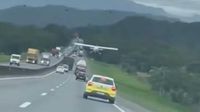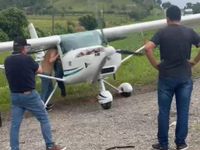On Saturday, April 5, 2025, a small single-engine aircraft made a forced landing on the BR-101 highway in Garuva, Santa Catarina, after experiencing engine failure. The incident occurred around 11:50 AM at kilometer 15 of the highway, which connects Curitiba to Joinville.
The aircraft, a Pelican 500 BR model manufactured by Flyer LTDA in 2007, was en route from the Garuva aeroclube to Joinville when the pilot was forced to make an emergency landing. Fortunately, there were no injuries reported among the two occupants: the pilot and the owner of the aircraft.
According to the pilot, it took approximately three minutes from the moment the engine failed until the landing was successfully completed. This was the first time both occupants had encountered such a situation. The aircraft has a total of 800 hours of flight time, with only seven hours logged since its last maintenance check.
Eyewitnesses captured the dramatic landing as the plane descended among vehicles on the busy highway. Images shared on social media showed the aircraft landing safely without colliding with any vehicles, much to the relief of motorists who were driving on the highway at the time.
Following the landing, the aircraft came to a stop on the shoulder of the road. The Arteris Litoral Sul, the concessionaire responsible for the highway, reported that the aircraft was quickly moved off the road, and traffic resumed flowing normally with both lanes open. However, a traffic jam formed in the area, reaching over two kilometers, persisting into the early afternoon.
Mechanics arrived at the scene to assess the condition of the aircraft. They were tasked with determining whether it was safe for the plane to continue its journey. If deemed airworthy, the BR-101 would be temporarily closed to allow for takeoff. If not, the aircraft would be partially dismantled and transported by truck.
The Federal Highway Police (PRF) confirmed that the aircraft did not collide with any vehicles during the forced landing and that no injuries were reported. The aircraft is classified as an experimental model with a maximum capacity of two occupants and a maximum takeoff weight of 600 kg. It is authorized for daytime VFR (visual flight rules) flights, and is in good standing with no registered liens or financial restrictions.
As investigations into the cause of the engine failure continue, authorities have emphasized the importance of maintaining safety standards for small aircraft. The incident serves as a reminder of the potential risks involved in aviation, even for experienced pilots.
In the aftermath, the local community has expressed gratitude that the situation did not escalate into a more serious incident. The quick response from the pilot, who managed to land the aircraft without causing harm to anyone on the ground, has been praised.
In summary, the forced landing of the Pelican 500 BR on the BR-101 highway was a significant event that highlighted both the unpredictability of flying and the importance of safety measures in aviation. With no injuries and a successful landing, it serves as a testament to the skills of the pilot and the resilience of the aircraft.








